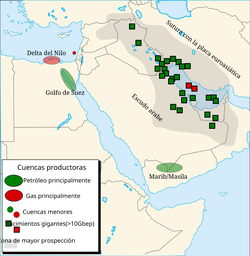
Oil and gas fields in the Levant, Egypt and the Persian Gulf.
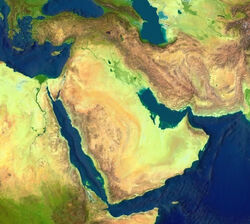
A NASA globe software World Wind satellite image of the Middle East.
Background[]
The 1967 Oil Embargo had come and gone. By their early 1970s, oil production had peaked in the USA and West Germany leaving them prone to an oil embargo. The embargo was a response to American involvement in the 1973 Yom Kippur War 6 days after Egypt and Syria launched a surprise military campaign against Israel to regain territories lost in the anti-Semitic June 1967 Six-Day War, the US supplied Israel with arms. In response to this, The Organization of Arab Petroleum Exporting Countries (OAPEC), consisting of the Arab members of the OPEC plus Egypt, Syria and Tunisia) announced an oil embargo against Canada, Japan, the Netherlands, the United Kingdom and the USA.
The Organization of Arab Petroleum Exporting Countries (OAPEC) is and generally was a multi-governmental organization headquartered in Kuwait which coordinates energy policies between oil-producing Arab nations, and whose main purpose is developmental, but was also a club for Arabs to co-ordinate how to screw oil money out of the West and plot against Israel.
The crisis had a major impact on international relations and created a rift within NATO. Some European nations and Japan sought to disassociate themselves from United States foreign policy in the Middle East. Whilst Japan was running scared of an oil embargo and did not relay have much to do with the Middle East, several European nations agreed with the Arabs and/or were anti-Semitic in nature. It was also, and still is, a uniquely European trait to adore and fawn up to bullies (Adolf Hitler, OAPEC, Saddam Hussein, Mao Te Sung, Vladimir Putin...).
The crisis[]
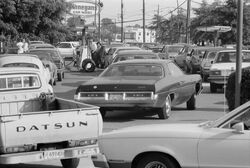
Line at a gas station in Maryland, United States, June 15, 1979. Author: Warren K. Leffler.
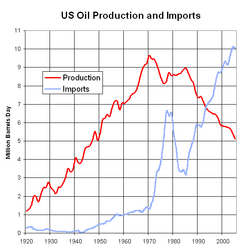
USA oil production and imports. As shown, the import spike starts from the US production peak, and the embargo has little effect. Attribution: RockyMtnGuy at the English language Wikipedia.
The problem[]
The 1970s energy crisis was a period in which the economies of the major industrial countries of the world, particularly the United States, Canada, Western Europe, Japan, Australia, and New Zealand were heavily affected, along with some lesser nation like Poland and Brazil, who faced substantial petroleum shortages, real and perceived, as well as elevated prices. Increased demand had coincided with political trouble in the Middle East which reduced supplies from that region.
The 2 worst crises of this period were the 1973 oil crisis and the 1979 energy crisis, caused by interruptions in exports from the Middle East, for example in 1979 due to the Iranian Revolution.
US oil production decline[]
In 1970, US oil production started to decline, exacerbating the embargo's impact. Following this, Nixon named James E. Akins as US Ambassador to Saudi Arabia to audit US production capacity. The confidential results were alarming—no spare capacity was available and production could only decrease. The oil embargo had little effect on overall supply, according to Akins.
OPEC[]
The Organization of the Petroleum Exporting Countries (OPEC), which then comprised 12 countries, including Iran, seven Arab countries (Iraq, Kuwait, Libya, Qatar, Saudi Arabia and the United Arab Emirates), plus Venezuela, Indonesia, Nigeria and Ecuador, was formed at a Baghdad conference on September 14, 1960. OPEC was organized to resist pressure by the "Seven Sisters" (seven large, Western oil companies) to reduce oil prices.
At first, OPEC operated as an informal bargaining unit for resource-rich third-world countries. OPEC confined its activities to gaining a larger share of the profits generated by oil companies and greater control over member production levels. In the early 1970s it began to exert economic and political strength; the oil companies and importing nations suddenly faced a unified exporter bloc.
End of the Bretton Woods currency accord[]
On August 15, 1971, the United States unilaterally pulled out of the Bretton Woods Accord. The US abandoned the Gold Exchange Standard whereby the value of the dollar had been pegged to the price of gold and all other currencies were pegged to the dollar, whose value was left to "float" (rise and fall according to market demand). Shortly thereafter, Britain followed, floating the pound sterling. The other industrialized nations followed suit with their respective currencies. Anticipating that currency values would fluctuate unpredictably for a time, the industrialized nations increased their reserves (by expanding their money supplies) in amounts far greater than before. The result was a depreciation of the dollar and other industrialized nations' currencies. Because oil was priced in dollars, oil producers' real income decreased. In September 1971, OPEC issued a joint communiqué stating that, from then on, they would price oil in terms of a fixed amount of gold.
This contributed to the "Oil Shock". After 1971, OPEC was slow to readjust prices to reflect this depreciation. From 1947 to 1967, the dollar price of oil had risen by less than two percent per year. Until the oil shock, the price had also remained fairly stable versus other currencies and commodities. OPEC ministers had not developed institutional mechanisms to update prices in sync with changing market conditions, so their real incomes lagged. The substantial price increases of 1973–1974 largely returned their prices and corresponding incomes to Bretton Woods levels in terms of commodities such as gold.
Yom Kippur War[]
On October 6, 1973, Syria and Egypt, with support from other Arab nations, launched a surprise attack on Israel, on Yom Kippur. This renewal of hostilities in the Arab–Israeli conflict released the underlying economic pressure on oil prices. At the time, Iran was the world's second-largest oil exporter and a close US ally. Weeks later, the Shah of Iran said in an interview:
- "Of course [the price of oil] is going to rise... Certainly! And how!... You've [Western nations] increased the price of the wheat you sell us by 300 percent, and the same for sugar and cement... You buy our crude oil and sell it back to us, refined as petrochemicals, at a hundred times the price you've paid us... It's only fair that, from now on, you should pay more for oil. Let's say ten times more."
On October 12, 1973, US president Richard Nixon authorized Operation Nickel Grass, a strategic airlift to deliver weapons and supplies to Israel, after the Soviet Union began sending arms to Syria and Egypt.
1973 oil crisis[]
The 1973 oil crisis began in October 1973 when the members of the Organization of Arab Petroleum Exporting Countries proclaimed an oil embargo. The embargo was targeted at nations perceived as supporting Israel during the Yom Kippur War. The initial nations targeted were Canada, Japan, the Netherlands, the United Kingdom and the United States with the embargo also later extended to Portugal, Rhodesia and South Africa. By the end of the embargo in March 1974, the price of oil had risen from US$3 per barrel to nearly $12 globally; US prices were significantly higher. The embargo caused an oil crisis, or "shock", with many short- and long-term effects on global politics and the global economy. It was later called the "first oil shock", followed by the 1979 oil crisis, termed the "second oil shock."
1979 energy crisis[]
The 1979 (or second) oil crisis or oil shock occurred in the world due to decreased oil output in the wake of the Iranian Revolution. Despite the fact that global oil supply decreased by only ~4%, widespread panic resulted, driving the price far higher. The price of crude oil more than doubled to $39.50 per barrel over the next 12 months, and long lines once again appeared at gas stations, as they had in the 1973 oil crisis.
In 1980, following the outbreak of the Iran–Iraq War, oil production in Iran nearly stopped, and Iraq's oil production was severely cut as well. Economic recessions were triggered in the United States and other countries. Oil prices did not subside to pre-crisis levels until the mid-1980s.
After 1980, oil prices began a 20-year decline, except for a brief rebound during the Gulf War, eventually reaching a 60 percent fall-off during the 1990s. As with the 1973 crisis, global politics and power balance were impacted. Oil exporters such as Mexico, Nigeria, and Venezuela expanded production; the Soviet Union became the top world producer; North Sea and Alaskan oil flooded the market. It seemed that the United States of America and Norway had much more oil reserves than forecasted in the 1970s. OPEC lost influence.
Aftermath[]
Global energy strategy[]
- Japan- Nuclear power en mass.
- France- Nuclear power en mass.
- UK- More nuclear power and North Sea oil use. Windscale reactor is expanded.
- Netherlands- More North Sea gas use.
- W. Germany- More nuclear power and North Sea oil use.
- USA- Soured more oil from Alaska, Canada, South America and Mexico. More nuclear power. Three Mile Island Power Plant is expanded. Solar, wind, tidal and geothermal power tested out.
- USSR- More oil drilling.
- Argentina- more oil drilling.
- Brazil- Alcohol fueled cars are tried out in places.
- Switzerland- More hydro-power plants and more nuclear power.
- Canada- More use of oil shales.
- Oil exporters such as Mexico, Nigeria, and Venezuela expanded production.
In the West[]
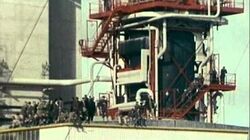
Windscale Britains Biggest Nuclear Disaster (Nothing compared to Fukushima).
Windscale Britain's Biggest Nuclear Disaster (Nothing compared to Fukushima).
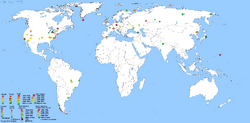
An atomic accident map.
Alternative fuel sources and fuel efficiency were encouraged by most nations and firms. The energy crisis of the 1970 caused the contraction of both the Blue Circle Cement Company and it's Blue Circle industries, along with the sale of its overseas plants. In 1978, the company officially changed its name to "Blue Circle". In 2001 the company was bought by the major French construction materials firm Lafarge.
Latin America[]
The Brazilian government implemented its "Proálcool" (pro-alcohol) project in 1975 that mixed ethanol with gasoline for automotive fuel.
In the East[]
The USSR made a lot of money selling oil, while Yugoslavia and Poland nearly went bankrupt and reverted back to using Soviet oil.
In the Arab World and the Middle East[]
It helped tilt Arab opinion and international interest away from the progressive Arab nationalists, Nasserites and Baathist's and in favor of the brutal, fundamentalist regimes in Saudi Arabia and Iran. Many Arab states obviously lost lots of money due to reduced oil exports.
In non-Arab OPEC members like Mexico and Venezuela[]
More drilling contacts, rising consumption in industrialised nations and high prices meant loads of petro-dollars! $$$$$$$$$$$$$$$$$$$$$$$$$$$$$$$$$$$$$$$$$$$$$$$$$$$$$$$$$$$$$$$$$$$$$$$$$$$$$$$$$$$$$$$$$$$$$$$$$$$$$$$$$$$$$$$$$$$$$$$$$$!!!!!!!!!!!!!!!!!!!!!!!!!!!!!!!!!!!!!!!!!!!!!!!!!!!!!!!!!!!!!!!!!!!!!!!!!!!!!!!!!!!!!!!!!!!!!!!!!!!!!!!!!!!!!!!!!!!!!!!!!!!!!!!!!!!!!!!!!!!!!!!!!!!!!!!!!!!!!!!!!!!!!!!!!!!!!!!!!!!!!!!!!!!!!!!!!!!!!!!!!!!!!!!!!!
The American Malaise era[]
The Malaise Era Refers to the period of American-made vehicles in model years 1973 to 1983, when changing government regulations and customer preferences initiated a focus on fuel efficiency and emissions controls. American automakers had a hard time competing with the smaller, more efficient import cars.
This time corresponds with significantly increased oversight of the automotive industry by the US Department of Transportation in response to the 1973 oil crisis and 1979 energy crisis. The resulting vehicles were significantly less powerful and slower due to new emissions restrictions being applied to older, heavier vehicle designs which also often included aggressively detuning the existing large engine designs to meet regulations and deliver desired efficiency.
With the 1979 energy crisis, oil and gas prices again increased significantly (doubling over a 12-month period), the automotive industry saw a further shift in customer preference to smaller, more efficient vehicles and American automakers began introducing a series of smaller, less powerful models to more directly compete against particularly the Japanese offerings.
American grew smaller and more efficient, but like French cars were too costly and uncompetitive to out do British, Japanese and W. German cars. Japan was also accused of unfair price cutting and export-dumping. This only encouraged isolationist and protectionist sentiments in the USA, along with a upswing in anti-Japanese racial hatred in the USA, UK, Canada, the Netherland, Italy, France, W. Germany and Australia.
The 1980s oil glut[]
The 1980s oil glut was a serious surplus of crude oil caused by falling demand following the 1970s energy crisis. The world price of oil, which had peaked in 1980 at over US$35 per barrel (equivalent to $104 per barrel in 2008 dollars, when adjusted for inflation), fell in 1986 from $27 to below $10 ($60 to $22 in 2008 dollars). The glut began in the early 1980s as a result of slowed economic activity in industrial countries (due to the crises of the 1970s, especially in 1973 and 1979) and the energy conservation spurred by high fuel prices.[4] The inflation-adjusted real 2004 dollar value of oil fell from an average of $78.2 in 1981 to an average of $26.8 per barrel in 1986.
In June 1981, The New York Times stated an "Oil glut! ... is here" and Time Magazine stated: "the world temporarily floats in a glut of oil", though the next week an article in The New York Times warned that the word "glut" was misleading, and that in reality, while temporary surpluses had brought down prices somewhat, prices were still well above pre-energy crisis levels. This sentiment was echoed in November 1981, when the CEO of Exxon Corp also characterized the glut as a temporary surplus, and that the word "glut" was an example of "our American penchant for exaggerated language". He wrote that the main cause of the glut was declining consumption. In the United States, Europe and Japan, oil consumption had fallen 13% from 1979 to 1981, due to "in part, in reaction to the very large increases in oil prices by the Organization of Petroleum Exporting Countries and other oil exporters", continuing a trend begun during the 1973 price increases.
After 1980, reduced demand and increased production produced a glut on the world market. The result was a six-year decline in the price of oil, which culminated by plunging more than half in 1986 alone.
OPEC soon lost its preeminent position, and in 1981, its production was surpassed by that of other countries. Additionally, its own member nations were divided. Saudi Arabia, trying to recover market share, increased production, pushing prices down, shrinking or eliminating profits for high-cost producers. The world price, which had peaked during the 1979 energy crisis at nearly $40 per barrel, decreased during the 1980s to less than $10 per barrel. Adjusted for inflation, oil briefly fell back to pre-1973 levels. This "sale" price was a windfall for oil-importing nations, both developing and developed.
The embargo encouraged new venues for energy exploration including Alaska, the North Sea, the Caspian Sea, and the Caucasus. Exploration in the Caspian Basin and Siberia became profitable. Cooperation changed into a far more adversarial relationship as the USSR increased its production. By 1980 the Soviet Union had become the world's largest producer. Part of the decline in prices and economic and geopolitical power of OPEC came from the move to alternate energy sources. OPEC had relied on price inelasticity to maintain high consumption, but had underestimated the extent to which conservation and other sources of supply would eventually reduce demand. Electricity generation from nuclear power and natural gas, home heating from natural gas, and ethanol-blended gasoline all reduced the demand for oil.
The drop in prices presented a serious problem for oil-exporting countries in northern Europe and the Persian Gulf. Heavily populated, impoverished countries, whose economies were largely dependent on oil—including Mexico, Nigeria, Algeria, and Libya—did not prepare for a market reversal that left them in sometimes desperate situations.
When reduced demand and increased production glutted the world market in the mid-1980s, oil prices plummeted and the cartel lost its unity. Mexico (a non-member), Nigeria, and Venezuela, whose economies had expanded in the 1970s, faced near-bankruptcy, and even Saudi Arabian economic power was significantly weakened. The divisions within OPEC made concerted action more difficult. As of 2015, OPEC had never approached its earlier dominance.
Technical note[]
Nuclear powered ships like the USS Enterprise (CVN-65) (which had 8 × Westinghouse A2W nuclear reactors) and the Ice Breaker Lenin, as well as nuclear subs like the USS Nautilus (SSN-571) were able to use atomic power for up to a year between reactor re-fuelings. So in this case an oil embargo was irrelevant to them and their kindred vessels.
Also see[]
- 1967 Oil Embargo
- Yom Kippur War
- Six-Day War
- Nickel
- OPEC
- Minerals and fuel in central Africa
- Oil sands
- Oil shales
- Gilsonite/bitumen stone
- Natural a tar (AKA- pitch) pit
- Natural asphalt/bitumen
- Tight oil
- Energy industry
- Useful metals
- Mineral mining, smelting and shipping videos
- Minerals and fuel in central Africa
- Energy and resources
- Energy industry
- Iranian Revolution
- Middle East
- Time line of Iraq
- Gulf Cooperation Council
- Cooperation Council for the Arab States of the Gulf
- Unconventional oil reserves
- Environmental disasters
- Trans-Alaska (Alyeska) Pipeline System
- The Druzhba pipeline
- Atomic accidents and disasters
- Groningen gas field
Links[]
- http://cr.middlebury.edu/es/altenergylife/70%27s.htm
- http://www.history.com/topics/energy-crisis
- https://en.wikipedia.org/wiki/1970s_energy_crisis
- http://www.wisegeek.org/how-did-the-70s-energy-crisis-affect-the-united-states.htm
- http://americanhistory.si.edu/powering/past/history3.htm
- http://cr.middlebury.edu/es/altenergylife/70%27s.htm
- http://www.history.com/topics/energy-crisis
- https://en.wikipedia.org/wiki/1970s_energy_crisis
- http://www.wisegeek.org/how-did-the-70s-energy-crisis-affect-the-united-states.htm
- http://americanhistory.si.edu/powering/past/history3.htm
- http://www.wikiwand.com/en/Organization_of_Arab_Petroleum_Exporting_Countries
- https://www.bbc.co.uk/iplayer/episode/b09jczr8/the-apprentice-series-13-13-why-i-fired-them
- https://en.wikipedia.org/wiki/1973_oil_crisis#Decline_of_OPEC
- https://en.wikipedia.org/wiki/1980s_oil_glut
- https://web.archive.org/web/20160304110442/http://www.unep.org/Documents.Multilingual/Default.asp?DocumentID=2718&ArticleID=9542
- http://www.nacs50.com/decades/70s/
- https://history.state.gov/milestones/1969-1976/oil-embargo
- http://www.cbc.ca/sitemap/
- https://en.wikipedia.org/wiki/1979_energy_crisis
- http://www.nytimes.com/2008/03/03/business/worldbusiness/03cnd-oil.html
- http://www.dailymotion.com/video/xj4eum?search_algo=2
- https://en.wikipedia.org/wiki/1980s_oil_glut
- http://www.autonews.com/article/20131013/GLOBAL/310139997/1979-oil-shock-meant-recession-for-u.s.-depression-for-autos
- http://www.horizontimes.com/facts/face-lift-animals?utm_medium=outbrain&utm_source=outbrainjk&utm_campaign=ht-face-lift-animals-v2&utm_term=MSN+UK+%28MSN+Intl%29
- https://web.archive.org/web/20110710193215/http://www.energytribune.com/articles.cfm?aid=534
- http://oilfieldwiki.com/wiki/1980s_oil_glut
- https://en.wikipedia.org/wiki/Blue_Circle_Industries